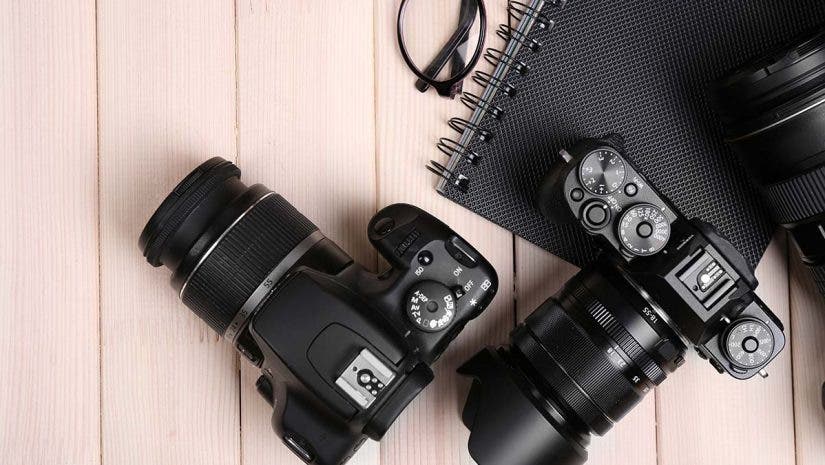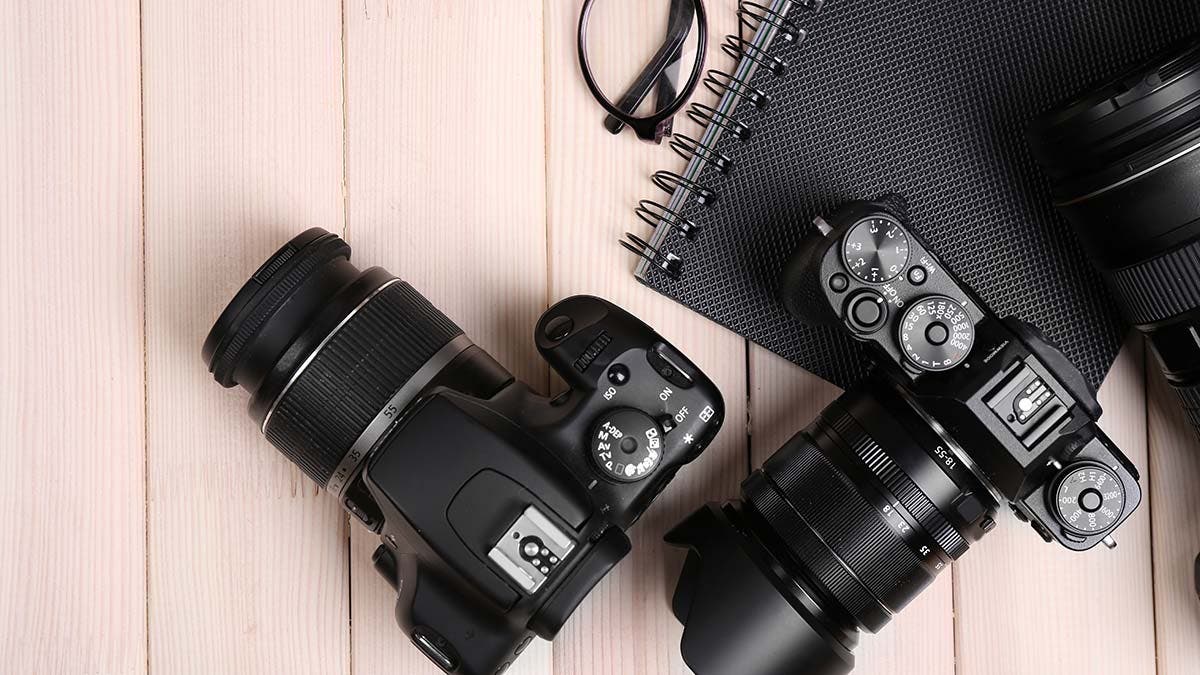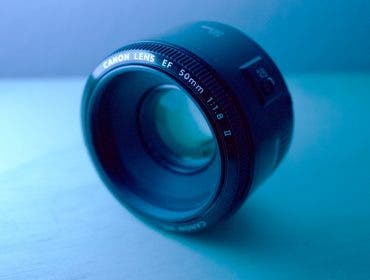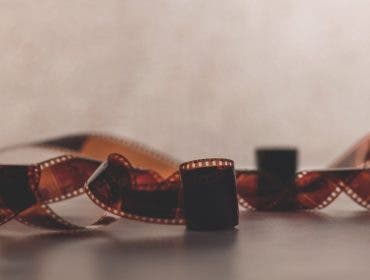Thanks to modern technology, not only has it become a regular everyday thing to capture photos (unlike during the earlier generations when only film cameras were available), but more and more types of cameras are being developed to suit every aspiring photographer and photography enthusiast’s artistic style and needs.
We’re sure you already know some of them. If you find yourself questioning which one you should get, read on. Getting to know the most popular types of cameras for photography is the first step in finding the best camera and camera brand for you.
Nowadays, cameras come in many different forms. These camera types include your favorite compact digital cameras, DSLRs, action cameras, new and improved film cameras, and even the latest mirrorless cameras. It may be hard to choose which type of camera to go for, but it’s easy to figure out which one will work best for you once you find out more about each of them, what they’re best for, and what their pros and cons are.
Whether you’re a beginner, a hobbyist, or a professional, you’ll find a specific type of camera that will fit your lifestyle and photography needs from our list below.
Types of Cameras for Photography
- Compact Digital/Point and Shoot Cameras
- Bridge Cameras
- Digital SLR Cameras
- Mirrorless Cameras
- Medium Format Cameras
- Action Cameras
- 360 Cameras
- Film Cameras
- Instant Cameras
- Smartphone Cameras
- Rugged Cameras
- Digital Cinema Cameras
- Drones
Compact Digital/Point and Shoot Cameras
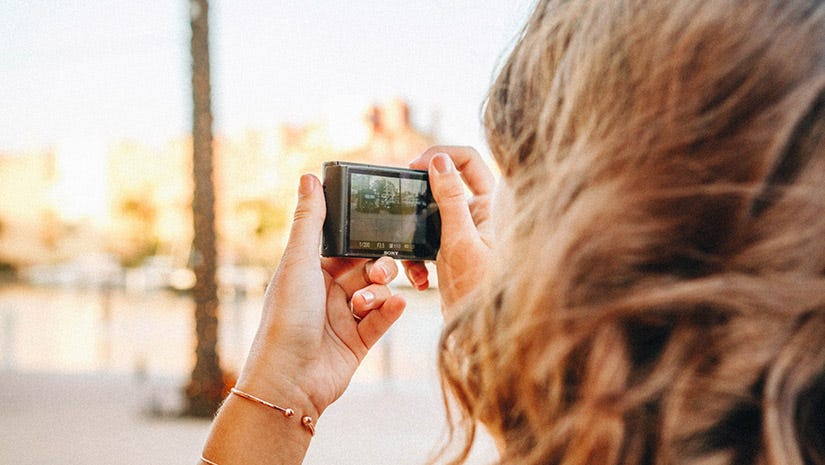
Compact digital cameras literally allow anyone to capture beautiful images by simply pointing the camera at the subject and clicking the shutter. Also known as a point-and-shoot camera, it is the most user-friendly of all camera types. It is smaller and lighter, and doesn’t require film or extra lenses. It also does all the hard work of automatically adjusting its settings to deliver well-exposed photos every time. You won’t have the freedom of adjusting the settings to your liking. However, with a good artistic eye and a knack for composition, you should have no problem producing great photos.
This walk-around digital camera is incredibly handy and surprisingly very durable, which is why you’ll probably still see people using their Canon and Sony digital compact cameras from over a decade ago. It fits right in your pocket or a small camera pouch, so it’s the perfect choice for photography enthusiasts who want to have the convenience of being able to take higher resolution snapshots (compared to most smartphone cameras) whenever, wherever.
Pros of Compact Digital Cameras:
- Very user-friendly
- Light and compact
- No need for film or extra lenses
- Full auto mode
- More affordable
Cons of Compact Digital Cameras:
- Usually can’t customize shutter speed and aperture
- Limited aperture and zoom range
- Noisier photos due to small sensor
- Lower resolution
- Slower focus
Who is this type of camera best for? Content creators or hobbyists who prefer a camera that performs well enough and provides lots of optical zooms, and is portable and travel-friendly, without having to carry interchangeable lenses or any other camera gear.
Top Option: The Panasonic LUMIC DC-ZS80D
The Panasonic LUMIC DC-ZS80D is a fantastic compact digital camera packed with features. It boasts a 30x optical zoom (equivalent to a 35mm camera lens of 24-720mm), 4K video shooting, a 3.0-inch tiltable rear monitor for a variety of different angles and vlogging opportunities, as well as a sharp 24mm ultra-wide angle lens, all in a pocket-size camera body that can travel wherever you go.
Bridge Cameras
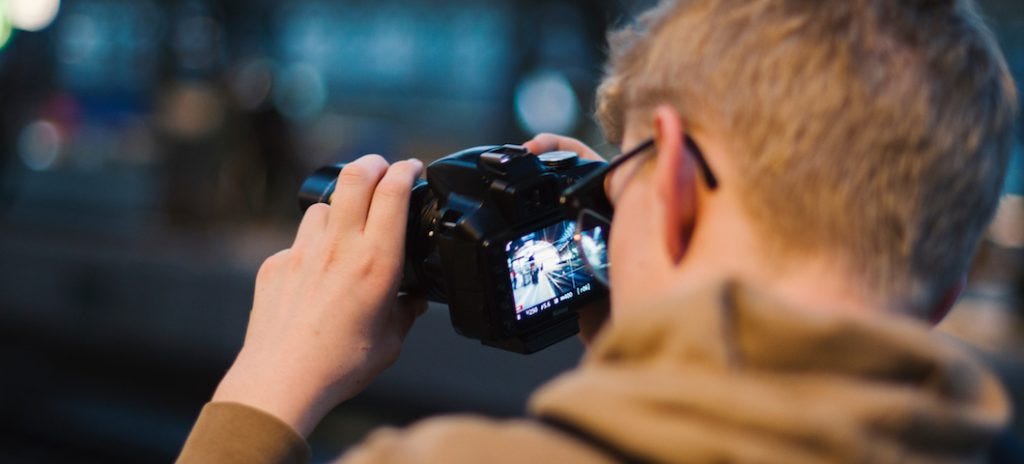
In general, a bridge camera is “somewhere between” a point and shoot and an interchangeable lens camera. It has a large zoom range, a viewfinder, and allows for some manual control of settings. It’s ideal for someone who has “graduated” from a point and shoot but isn’t ready yet to invest in an interchangeable lens camera (ILC) system or doesn’t want the inconvenience of carrying around and changing multiple lenses.
Bridge cameras typically have image sensors that are smaller than those found in interchangeable lens cameras but larger than in most point and shoots. Two of the more popular bridge cameras are the Sony RX10 IV and Panasonic LUMIX DC-FZ1000M2. Both offer incredible focal length range (24-600mm for the Sony and 25-400mm for the Panasonic) and fairly bright apertures. They also use a 1-inch sensor, which will produce much better-quality images than from a typical point and shoot camera sensor. The Sony is also weather sealed in case your photography adventures take you to harsh environments.
Bridge cameras often find themselves in the bags of travel photographers who want to capture a variety of subject matter while keeping equipment to a minimum. As long as you’re comfortable with the limitations of just one lens, smaller sensor size than most interchangeable lens cameras, and somewhat slower operational speed, a bridge camera such as the Sony or Panasonic are good options.
Pros of Bridge Cameras:
- A single camera and lens for most focal length needs
- Superior image quality to most point and shoot cameras
- Budget friendly when compared to and ILC and multiple lenses
- A good balance between portability and versatility
Cons of Bridge Cameras:
- Single lens may not be ideal for specialized needs such as ultra-wide angle or extreme shallow depth of field portrait photography
- Usually more expensive than simple point and shoots
- Most are still not “pocketable”
- Slower operational speed than ILC
Who is this type of camera best for? Content creators or hobbyists who prefer a camera that balances the benefits of a point-and-shoot with the size and layout of a DSLR. Their superzoom capabilities paired with their wide angle base focal length make them great options for travel and sightseeing as well.
Top Option: The Sony DSC-RX10 IV
The Sony DSC-RX10 IV is a top-of-the-line bridge camera with an impressive superzoom of 24-600mm and a 1” stacked BSI-CMOS sensor. Its faster processor, borrowed from Sony’s flagship Sony A9 camera, as well as phase-detect autofocus, and ability to shoot 4K footage, make it a fantastic choice for those who prefer the balance between a point-and-shoot camera and DSLR camera that a bridge camera provides.
Digital SLR Cameras
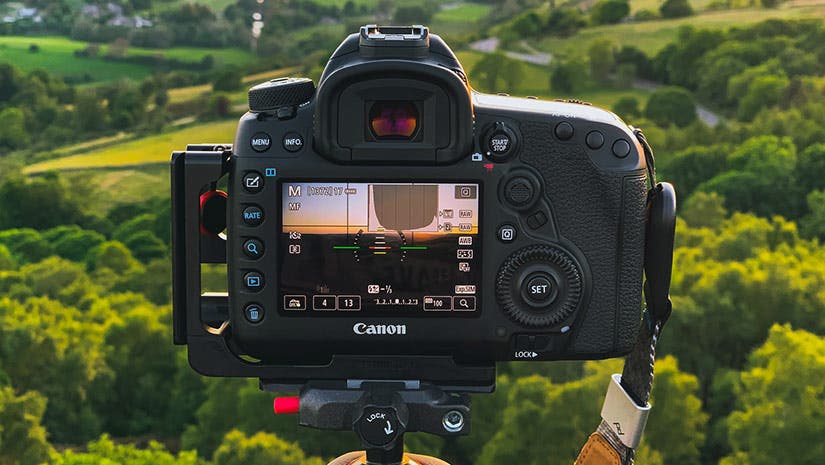
DSLR (or digital single lens reflex) cameras take photos to the next level of image quality. This more “serious” type of camera is best known for delivering remarkably sharp and spectacular images. It produces beautiful background bokeh, and even high resolution videos with the help of their advanced sensors, manual settings, and wide range of interchangeable lenses.
Today, professional photographers and videographers from around the world mostly use DSLRs (now alternatively known as hybrid single reflex lens cameras or HDSLR) for commercial purposes. Many of Canon’s and Nikon’s DSLR cameras are being used for capturing hi-res images for magazines and billboards, and even full HD 1080p videos at up to 60fps for television shows and movies.
Pentax DSLRs are also well-known for being the perfect camera buddy for shooting under the most difficult weather situations.
While they are considered high-end, there are more affordable entry-level DSLRs for beginners. They are suitable for almost every kind of photography out there, so literally anyone—from hobbyists to event and sports photographers—can opt for this type of camera.
There are two types of DSLRs: the full-frame or 35mm, and the crop sensor or APS-C.
A full-frame DSLR camera has a 36x24mm sensor, which typically yields better image quality and low-light capability. They also tend to be more expensive than their crop sensor counterparts, which covers less of the image projected by the lens due to the smaller sensor.
Pros of DSLRs:
- Fully customizable settings
- Large sensors for cleaner images
- Optical viewfinder
- High-resolution photo output
- Full HD to UHD video output
- Wide variety of camera body and lens choices
Cons of DSLRs:
- Bigger and bulkier
- Higher cost
- Requires ample know-how
Who is this type of camera best for? Photographers, videographers, and content creators who prefer a DSLR design, robustness, and superior battery life, over mirrorless and want access to a plethora of interchangeable lens options and camera body options for all levels and experience
Top Option: The Nikon D850
The Nikon D850 has been considered by many to be one of the best full-frame DSLR cameras ever made, specifically for professional photographers. Its high-resolution 45.7 MP backside-illuminated CMOS sensor and 153-point AF system paired with a 180,000-pixel metering system make the Nikon D850 powerful, fast, and tact-sharp, producing brilliant imagery at the highest level.
Mirrorless Cameras
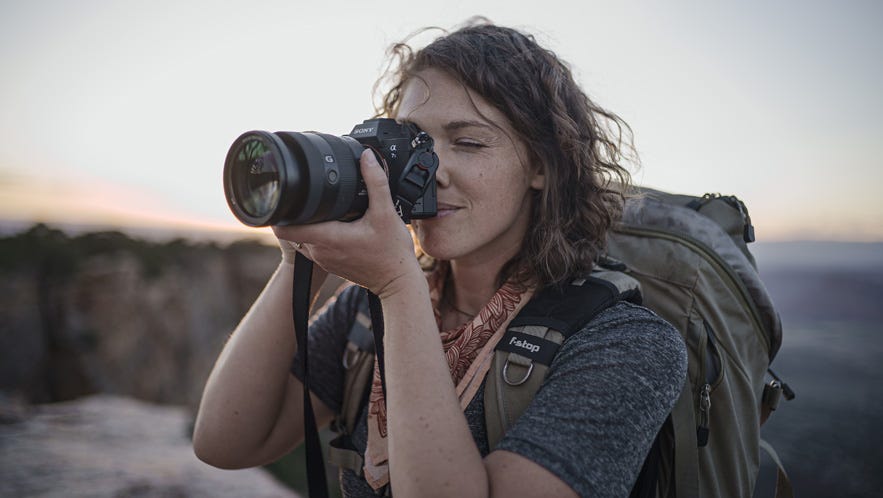
Mirrorless cameras are the latest in professional cameras. They are basically more compact DSLRs without the internal mirror that reflects light onto the sensor.
What’s interesting about mirrorless cameras is that they are now capable of capturing incredible, high-resolution images with even faster shutter speeds and record ultra HD videos that only the most expensive, higher-end DSLRs can produce.
Overall, it’s a combination of two popular types of digital cameras—a point-and-shoot for its compact size and somewhat simpler controls, and a DSLR for its interchangeable lenses and impressive output.
Read this to learn more about the differences between a mirrorless and a DSLR camera: Mirrorless vs. DSLR: How Do They Compare?
Similar to the DSLR, mirrorless cameras also come in two types: full-frame and crop sensor. There aren’t many full-frame mirrorless cameras on the market at the moment, but if you’re a professional shooter who’s interested in one, check out some of the premium offerings from Sony and Leica here at Adorama.
Pros of Mirrorless Cameras:
- Electronic viewfinder
- Smaller and lighter
- Simpler operation and controls
- Faster and better for video
- Higher video quality even in lower-end models
- Shoots more images at faster shutter speeds
Cons of Mirrorless Cameras:
- Shorter battery life
- Slower autofocus
Who is this type of camera best for? Photographers, videographers, and content creators who prefer the latest and greatest camera technology that marries perfectly with the newest, most advanced lens on the market. They’re also great for people that prefer a far more portable and travel-friendly option than a DSLR.
Mirrorless cameras are also far superior to DSLRs when it comes to video, so if you prioritize video content or filmmaking, mirrorless cameras are for you.
Top Option: The Canon EOS R8
The Canon EOS R8 is a new full-frame mirrorless camera that offers a fantastic entry-level option that is travel-friendly and Canon’s lightest full-frame mirrorless camera, but also feature-heavy, with specs like a 24.2 MP full-frame CMOS image sensor, fast, accurate autofocus with head, face, and eye tracking, and the ability to capture 4K 60p footage.
Medium Format Cameras
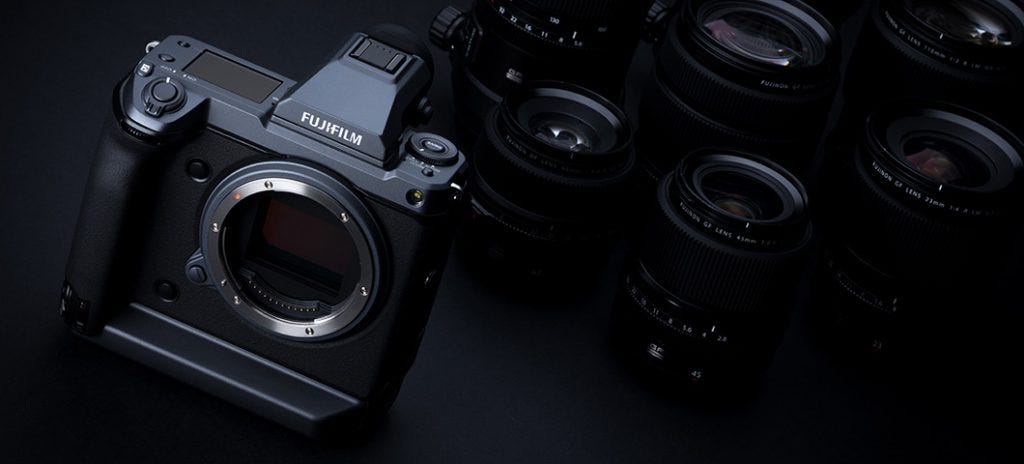
This section will focus on the digital version of medium format cameras, which, in general, have sensor sizes that are smaller than film medium format. However, medium format sensor size is larger than a full frame sensor, which generally translates to higher quality images.
Medium format cameras also produce shallower depth of field, produce smaller equivalent focal length, and have more dynamic range when compared to a full frame camera. For example, on the Fuji GFX 100S medium format digital camera there is a crop or magnification factor of approximately 0.8. Therefore, a 100mm lens for that camera would be equivalent to 80mm on a full frame sensor. Similarly, if the aperture was set to f/4, the full frame equivalent would be about 3.2.
Because of the larger surface area of the sensor and typically larger pixel size, the resulting image quality and noise profile is also better. Because medium format cameras are generally slower (e.g., autofocus speed and frames per second) and produce much larger image files, they are usually not as well suited for fast moving action (e.g., birds in flight) or sports photography. Medium format cameras are mainly used for studio and landscape work. However, with evolving technology, this is changing.
Pros of Medium Format Cameras:
- Excellent image quality
- Low Noise
- Higher Resolution
- Shallower depth of field for that “medium format look”
Cons of Medium Format Cameras:
- Generally, more expensive than full frame cameras
- Usually physically larger with larger/heavier lenses
- Lower frames per second
- Slower to autofocus
Who is this type of camera best for? Photographers that prefer higher resolution and better-quality images. Medium format cameras have larger sensors than full-frame cameras, which allows for maxim resolution and higher image quality.
Top Option: The Fujifilm GFX50S II
The Fujifilm GFX50S II is one of the top medium format cameras ever made and is so impressive, it might just make you rethink medium format. The GFX50S II sports a massive 51.4 MP sensor approximately 1.7x bigger than every full-frame camera sensor on the market. It’s light yet durable, weighing under 2 lbs with impressive weather-resistant construction, making it durable and lightweight enough to travel anywhere with, and its impressive autofocus system and in-body stabilization make it a true winner as a professional medium format camera, that can match up with the best cameras on the market.
Action Cameras
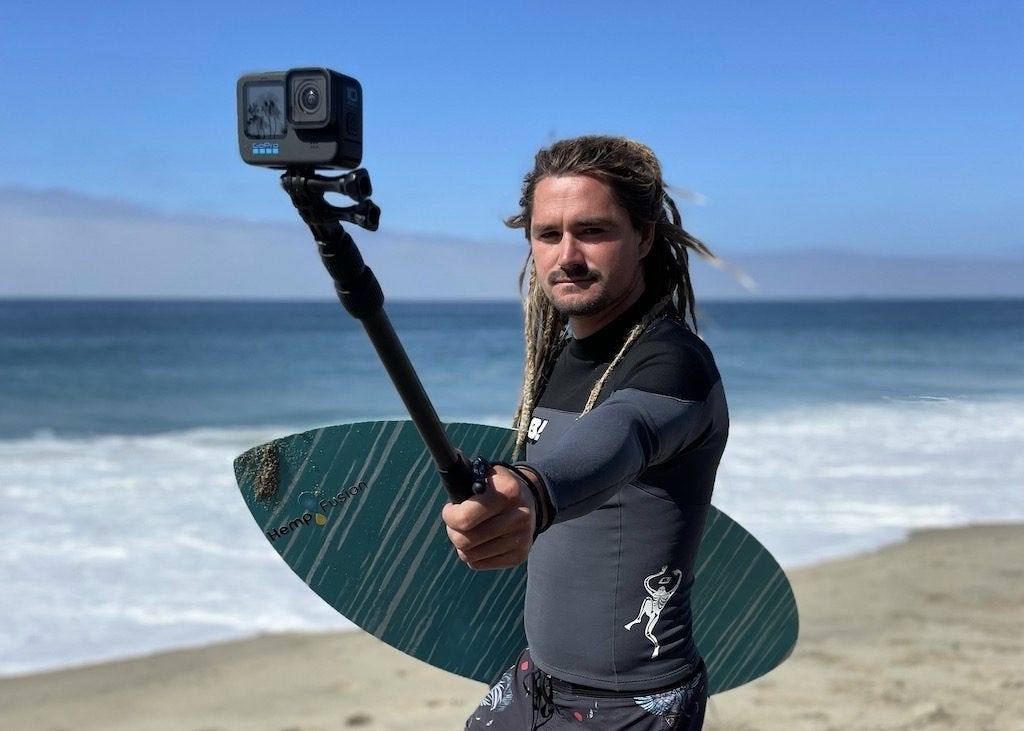
We’ve definitely seen the abundance and rising popularity of action cameras in the past few years. Common action cameras like the GoPro can fit in the palm of your hand, but they’re some of the most durable and versatile types of digital cameras that offer very high-resolution output.
A wide range of accessories like waterproof housing and mounts allow the user to attach action cameras to helmets, bicycles, and even drones, which enable hands-free shooting in different types of situations. This opens up a whole new world of photographic possibilities. This type of camera allows you to capture impressive wide-angle photos and videos with sound from almost any angle and environment. Take them underwater or on top of a mountain.
If you’re the adventurous or sporty type and simply want to take breathtaking photos and videos that will “take you back” to those moments, action cameras are for you.
Pros of Action Cameras:
- Rugged and compact
- Lightweight
- Versatile and mountable on almost any surface
- Remote view and shutter via smartphone
Cons of Action Cameras:
- Viewfinder too small, if available
- Exposure settings not fully customizable
- Fixed focus
- Limited digital zoom
Who is this type of camera best for? Content creators that want to capture a unique perspective of the activity, they are participating in, through quality photos and videos. Because action cameras are so small and lightweight, they are easily mountable to vehicles, gear, and even humans and animals, making content options endless.
Top Option: The GoPro HERO11 Black
GoPro pioneered the action camera and has been raising the bar to what action cameras are capable of for years. Its latest action camera, the GoPro HERO11 Black, raised the bar even higher. With features like 5.3K video, 27 MP photos, award-winning HyperSmooth 5.0 stabilization, dual LCD screens, and much more, the GoPro HERO11 Black might just be the best action camera ever built.
360 Cameras
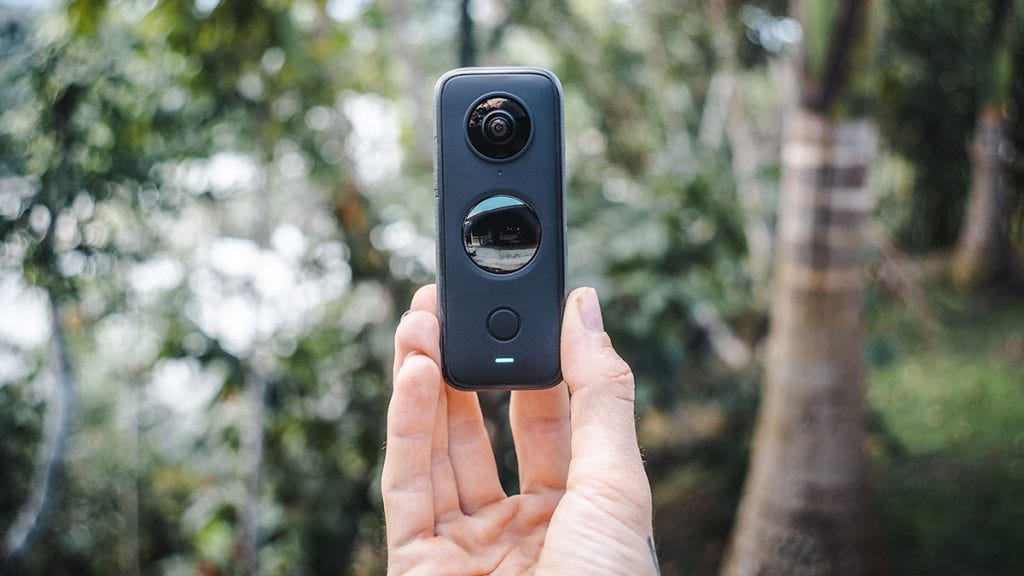
The 360-degree camera takes half dome to full-circle panoramic photos and videos using back-to-back lenses. Like action cameras, some of them are also water resistant and mountable on many surfaces, such as on top of cars, helmets, or drones. Above all, they take the most realistic pictures and videos with stunning panoramic views that you can truly immerse yourself in, virtual reality style.
It’s a very good camera choice for taking vacation photos that you can proudly show off to your loved ones and on social media. After all, we still can’t get enough of this new Google Streetview-style photography and videography. However, because of its non-traditional output, images cannot be printed unless they are cropped as a rectangular panoramic frame.
It can also be a challenge to produce perfect panoramic shots because a lot can go wrong with the image stitching and composition (especially since it’s hard to hide the camera director in the shots). But when it works, the results can be truly exceptional.
While mostly geared toward hobbyists, professional photographers can also benefit from this type of camera if they wish to create highly unique, immersive digital photos that allow them to capture a certain scene from all angles.
Pros of 360 Cameras:
- Small and lightweight
- Versatile and mountable on almost any surface
- Takes very realistic 360-degree photos and videos
- Allows live view or streaming
Cons of 360 Cameras:
- Lower resolution output
- Sensitive to camera shake and blurring
- Fixed focus
- Limited digital “pinch” zoom, if available
- Can be challenging to frame shots
- For digital viewing only
Who is this type of camera best for? Content creators who want to capture unique photo and video content and prefer the 360 content look.
Top Option: The Ricoh THETA SC2 4K 360 Camera
Gone are the days of complicated 360 cameras. The Ricoh THETA SC2 4K 360 Camera makes 360 content easy with its simple and sophisticated design and front button operation. Its two ultra-wide lenses, each with a 1/2.3 CMOS sensor allow for improved image quality and even 4K 360 footage, all in a portable, lightweight design and reasonable price.
Film Cameras
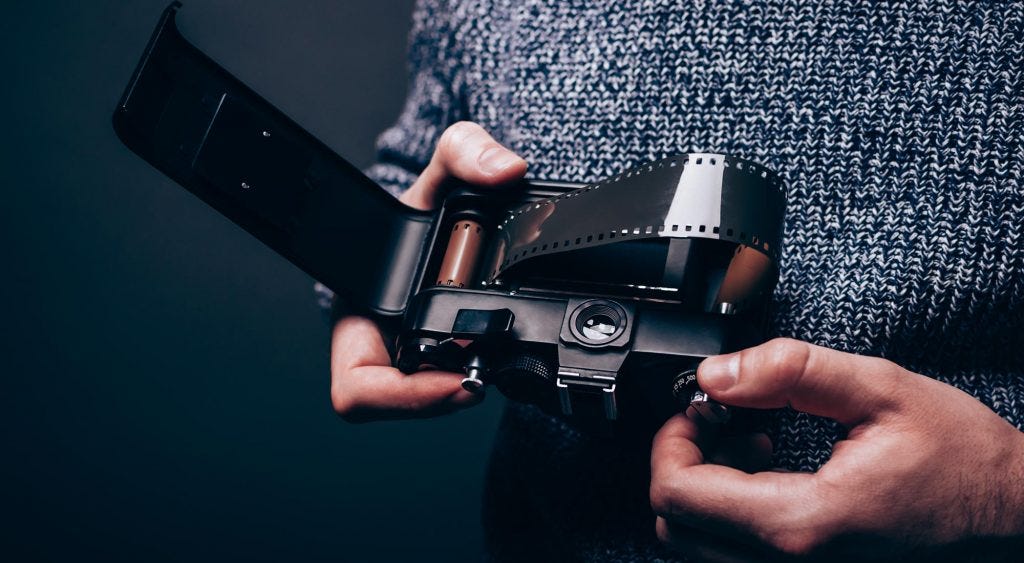
Film cameras may seem outdated in our new digital world, but they are by no means obsolete.
There are many types of film cameras and they provide more artistic output than ever before. Much to the delight of film photography enthusiasts, there are still classic 35mm film cameras being sold today with improved bodies and enhanced capabilities.
The younger generation has learned to love film cameras, thanks to the birth of instant and lomography cameras, which produces (and sometimes prints out) vintage-style photos with vignettes and Instagram-style “filters” with every click of the shutter. Rangefinder cameras, which manually measure subject distance, have been improved while retaining the vintage body and analog settings.
Medium format film cameras provide an even bigger surface frame (up to 4 times bigger than the usual 35mm, but smaller than large format) and is widely-used by gallery artists for its capability to develop huge prints without losing image quality and to capture natural-looking, wide-angle shots as our eyes actually see them in the real world.
Film cameras obviously require more hard work in achieving your desired images, but they are loved for their unmatched ability to produce gorgeous, artistic photos that are great for galleries and photo albums. Follow our guide to film photography to begin your journey.
Pros of Film Cameras:
- Image resolution and size (for medium and large format)
- Beautiful, artistic photos
- Vintage-looking hardware
- Cheap, good quality lenses
Cons of Film Cameras:
- Analog settings
- Expensive and recurring film cost
- No internal light meter
- Risk of parallax, focus, and exposure errors
Who is this type of camera best for? Photographers who like or prefer the timeless, vintage look of film photography, and/or want to learn how to master exposure settings
Top Option: The Yashica MF-2 Super DX 35mm Film Camera
The Yashica MF-2 Super DX 35mm Film Camera is an affordable film camera that offers a vintage, 90s-inspired look to your images. Its compact point-and-shoot design allows you to take it with you in your camera bag, as the perfect sidekick to your main camera, and its easy-to-use exposure settings allow the user to learn and master the fundamental rules of photography.
Instant Cameras
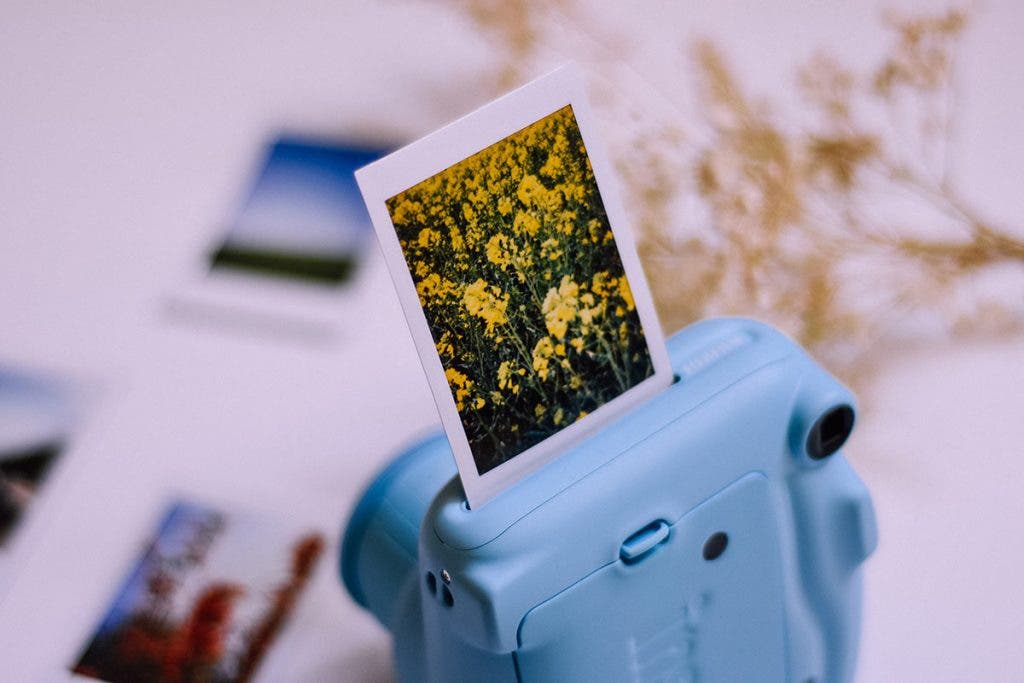
In recent years, instant film has made a strong resurgence. There are a variety of reasons why you should consider purchasing an instant camera. The biggest benefit of an instant cameras is it allows you to give a physical copy (print) of the image to anyone right after taking the picture. This feature alone has changed the way many photographers approach their craft, such as event or wedding photography. Instant cameras also appeal to the casual photographer who might want to handout keepsakes at a family gathering or when out with friends.
With the recent concentration on social media privacy and growing mistrust for on-line digital distribution of images, an instant camera seems to have found a home with the younger generation of photographers who prefer to keep physical versions of the images over digital ones.
There are several brands of Instant cameras, with Fujifilm Instax being one of the most popular. The mini version will produce images about the size of a credit card while Instax Wide will allow you to print a size approximately double that. Both color and black and white media are available. Buying the paper in bulk can make the price of individual prints quite affordable.
Pros of Instant Cameras:
- Instant physical prints
- Great for gatherings and parties
- Durable media
- Various sizes available
- Color or Black and White media
Cons of Instant Cameras:
- Print is generally not as detailed as from a dedicated photo printer
- Dynamic range and colors are also not as good as lab prints
- Different sizes are available but are usually still no larger than 5” x 7”
Who is this type of camera best for? Content creators or hobbyists who want to create a physical image of a moment for mementos, keepsakes, or scrapbooking. They might not take the best image possible, but the instant gratification of physical print is something many people love.
Top Option: The INSTAX MINI 12 Instant Camera
The INSTAX MINI 12 Instant Camera is a fun, vibrant instant camera that offers plenty of fun color options alongside easy-to-use controls, modes, and automatic exposure, making sure you never miss a moment. Just simply aim and click, and you have a fun, physical image that documents the memories you want to remember.
Smartphone Cameras
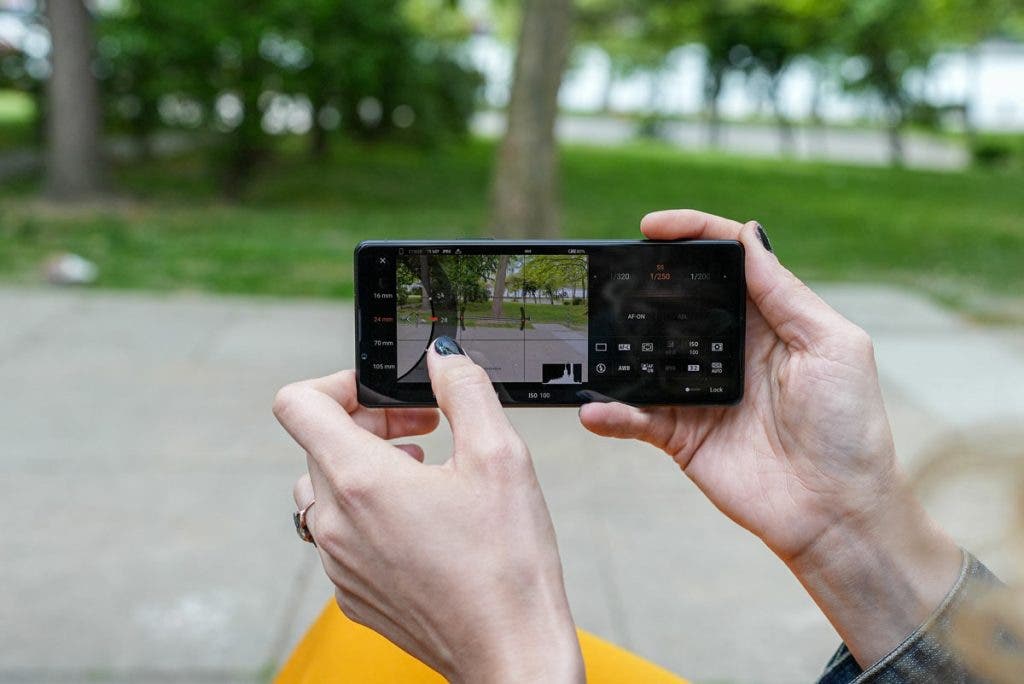
We all know the adage that the best camera is the one you have with you. This saying isn’t truer than for the smartphone cameras. Arguably, the most significant advances in digital photography in recent years have been in smartphone cameras. According to many online sources, images taken with smartphone cameras vastly outnumbers those taken by any other format.
Computational photography allows for sought after features such as simulated shallow depth field, automatic blending of files to produce noise free images, and easy removal of unwanted elements from photos. The latest generation of cameras on iPhones and Android devices allow for incredible zooming capabilities, RAW image capture, and 8K video, just to name a few features.
Many apps are also available for photo editing to further enhance the look and quality of images from a smartphone. Although the sensors on these are usually tiny compared to dedicated cameras, the advanced software features and integration of hardware allow them to overcome this handicap.
Modern smartphones also come with several lenses build in, both in front and at the rear. It is not uncommon to have a 12 – 40 MP selfie camera and up to 108 MP rear facing sensors. The lenses range from ultra-wide to extreme telephoto. You can also buy mobile add-on lenses for improved photo abilities.
Strong built-in image stabilization has allowed many smartphones to produce handheld night shots that are noise free and well exposed, something impossible to do just a few years ago.
Pros of Smartphone Cameras:
- Always with you
- Robust computational photography features
- Variety of built-in lenses
- Instant sharing
Cons of Smartphone Cameras:
- In certain situations, computational photography can’t overcome downsides of a small sensor
- Only prime lenses available with digital zooming between focal lengths
- “Digital” look to images
Who is this type of camera best for? Content creators who want a powerful content creation tool, but don’t want to lug around or invest in camera gear. For many, smartphones, like the iPhone 14 Pro, provide more than enough photo and video features to create quality, engaging, and exciting content for social media and more.
Top Option: iPhone 14 Pro/14 Pro Max
The iPhone 14 Pro and 14 Pro Max offer image and video quality that is so good, it’ll make you question if it was really shot from a phone. Offering image quality up to 48 MP with Apple ProRAW and video features like 4K 60p and Cinematic mode up to 4K HDR 30p, with some of the best low light performance of any phone camera to date, the iPhone 14 Pro and 14 Pro Max is a must for any content creator.
Rugged Cameras
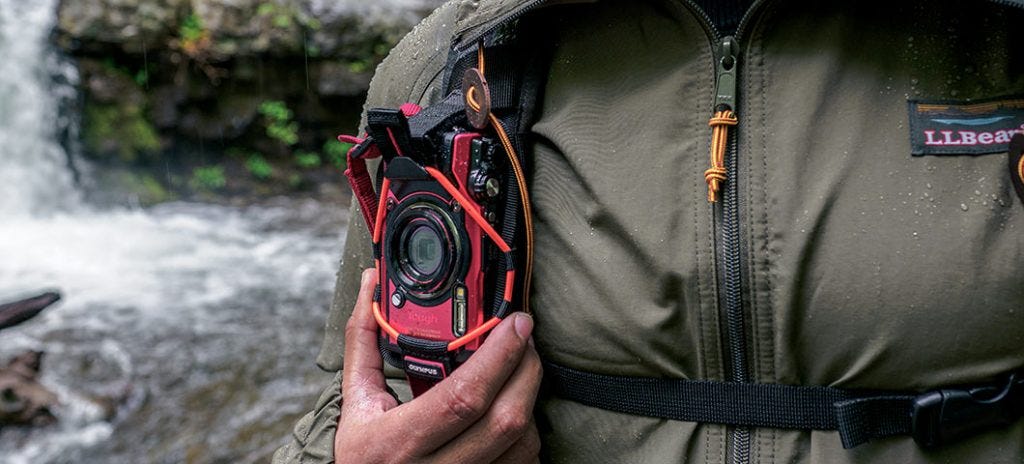
What exactly makes a camera “rugged”? Most people will likely mention a camera that is waterproof or freeze-proof or one that can survive a drop from a certain height. So, it all depends on your definition of “rugged”. For the purposes of simplicity and fairness, let’s only include cameras that are waterproof and can withstand a few tumbles.
If you read reviews, one of the best rugged cameras is the Olympus Tough TG-6 is frequently at the top of the list. It’s reasonably priced, waterproof (50 feet /15 meter), dust proof, shock proof (7 feet / 2.1 meter), crush proof (100 kgf), freeze proof (14 degree Fahrenheit / -10 degree Celsius), and has an anti-fog coating.
A lot of action cams, such as the GoPro Hero10 Black, are also considered rugged cameras and are ideal for outdoor and underwater adventures. You’ll have to sacrifice a bit of overall image quality or focal length versatility when using a rugged camera because the lens coating/cover needs to prioritize sturdiness over absolute best optical quality glass. The system also needs to be completely self-contained and sealed or be placed in a housing. However, if you’re willing to spend a little extra and don’t want to sacrifice image quality, you should look into an underwater housing for your ILC.
Pros of Rugged Cameras:
- Very resistant to the environment
- Usually small and portable
- Reasonable image and video quality
Cons of Rugged Cameras:
- Some sacrifice of image quality for ruggedness
- Single, non-interchangeable lens
- Small sensor size
Who is this type of camera best for? Content creators who want the ruggedness of an action camera but the form factor of a point-and-shoot camera that is easier to hold and operate quickly
Top Option: The Olympus Tough TG-6
The Olympus Tough TG-6 is a rugged, capable camera that is built for adventure photographers that prefer the form and function of a point-and-shoot camera over an action camera. The Olympus Tough TG-6 features a 12-megapixel sensor, 4x optical zoom, and 4K movie recording, built with an incredibly durable, weatherproof construction, so you can take it just about anywhere and capture amazing moments in the outdoors.
Digital Cinema Cameras
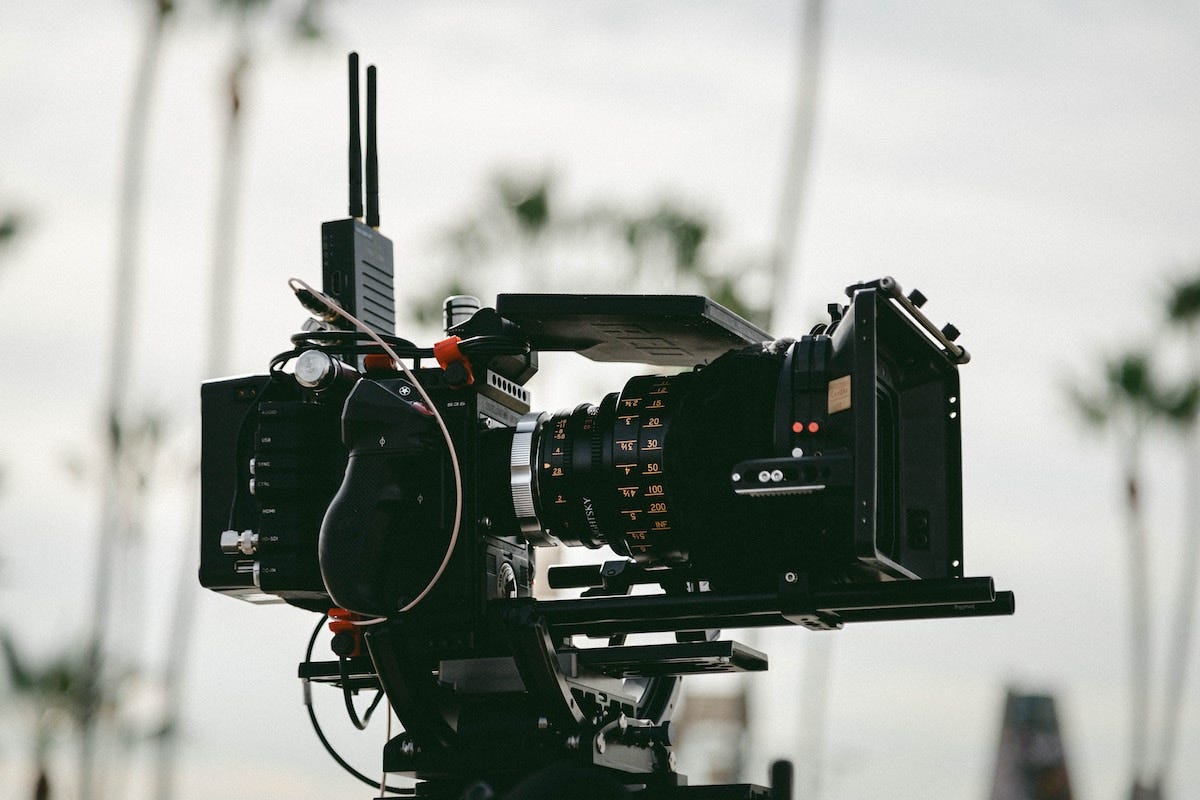
Digital cinema cameras are specialized cameras designed specifically for professional filmmaking and video production. Unlike consumer-grade cameras, digital cinema cameras are built with larger sensors, higher resolutions, and more advanced features to capture cinematic footage with exceptional quality.One of the main features of digital cinema cameras is their ability to capture video in high resolutions such as 4K or even 8K, which allows for greater detail and clarity in the final image.
Digital cinema cameras also offer advanced color grading options, which allow filmmakers to fine-tune the color and contrast of their footage to create a particular aesthetic. They often also support the RAW format, which provides the highest quality image and the most flexibility in post-production. Overall, digital cinema cameras are essential tools for professional filmmakers and video producers who demand the highest quality and performance from their equipment.
Pros of Digital Cinema Cameras:
- High resolution for greater detail and clarity
- Larger sensors than consumer cameras
- Advanced color grading options
- Supports the RAW format
- Robust construction and ergonomic controls for precise handling and control
Cons of Digital Cinema Cameras:
- Higher initial cost
- Requires greater battery power to run
- Less direct control over exposure settings
Who is this type of camera best for? Filmmakers and content creators who want the highest level of video quality possible, for client work, film projects, and more. Digital cinema cameras are the future and offer the latest technology in video, so while they come with a hefty price tag, they are well worth the investment.
Top Option: The Blackmagic Design Pocket Cinema Camera 6K Pro
The Blackmagic Design Pocket Cinema Camera 6K Pro is one of the most affordable, compact, feature-packed, digital cinema cameras on the market today. The Blackmagic Design Pocket Cinema Camera 6K Pro’s ability to shoot 6K footage with 13 stops of dynamic range and dual native ISO up to 25,600 allows it to capture stunning footage, no matter the light conditions. Its smart, functional features like an adjustable 5-inch LCD, built-in ND filters, two mini XLR audio inputs, and fantastic battery life make it a winner as a cinema camera for run-and-gun filming.
Drones
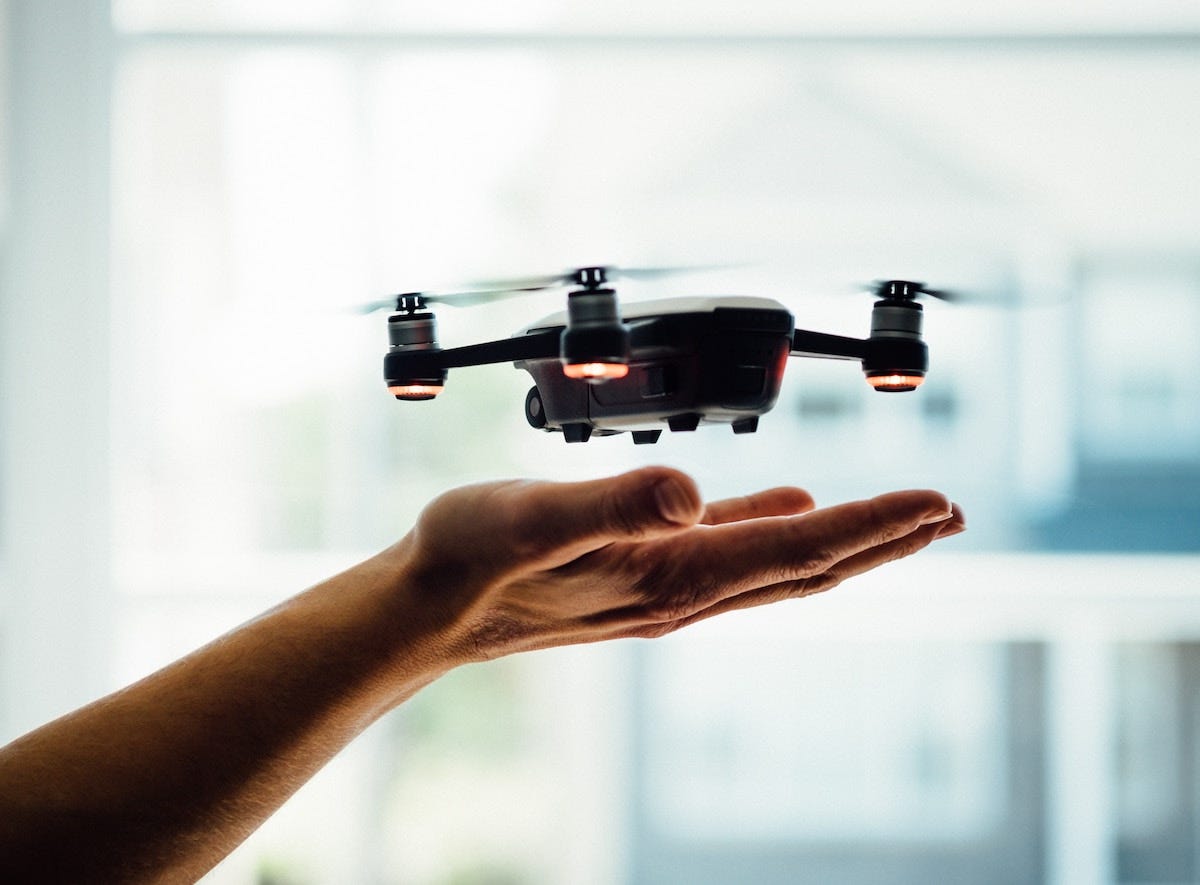
Drones have become an indispensable tool for photographers and videographers alike. They offer a unique perspective that is impossible to achieve with traditional camera equipment, giving professionals access to stunning aerial views that would otherwise be difficult or impossible to capture. Drones are highly maneuverable, allowing photographers to reach tight spaces and difficult-to-access areas, making them ideal for capturing images of landscapes, buildings, and other subjects that are challenging to photograph.
Drones can cover a large area in a short amount of time, making them an ideal tool for capturing images of large events or landscapes. This makes them a cost-effective tool for aerial photography, as they can capture high-quality footage quickly and efficiently.
Pros of Drones:
- Unique perspective and ability to capture aerial views
- Highly maneuverable and can reach tight spaces and difficult-to-access areas
- Equipped with high-quality stabilization systems
- Able to cover a large area in a short amount of time
- Advanced safety features, such as collision avoidance systems and GPS tracking
Cons of Drones:
- Pilots are now required to be fully certified with the FAA
- Prosumer and pro-level drones still can’t match up to the quality of professional mirrorless or digital cinema cameras
- Limited or unusable in poor weather conditions and extreme temperatures
- Drones are quite noisy and polarizing and can cause unwanted, negative attention
Who is this type of camera best for? Drones are made for a multitude of people. From hobbyist pilots to professional content creators and FPV pilots, drones offer something for just about anyone that loves to fly and offer a unique, bird’s eye perspective that is powerful, valuable, and engaging.
Top Option: The DJI Mavic 3 Classic
The DJI Mavic 3 Classic offers a more affordable option in the DJI Mavic 3 series, without losing out on the top features that make this drone series so impressive. The DJI Mavic 3 Classic offers a powerful Hasselblad-designed, professional-grade 4/3 CMOS sensor that provides incredible dynamic range and low-light performance, the ability to shoot footage up to 4K 120p at 10-bit D-log, an impressive 46-minute max flight time, and more, all the portable, foldable quadcopter drone design we know and love. The Mavic 3 series is the next phase in the evolution of drone content, and the DJI Mavic 3 Classic is a fantastic choice for professionals and enthusiasts alike.
What’s the Best Type of Camera for Photography?
The two best camera options for professional quality photography are DSLRs and mirrorless cameras. Thanks to higher megapixel counts, impressive processessors, a wide range of compatible lenses and useful accessories, and endlessly adjustable settings, both mirrorless cameras and DSLRs offer the greatest range of customization and high-quality imagery.
While many robust compact digital cameras, action cameras, and 360-degree cameras exist, each of these is more limited in its scope and functionality. Each type works quite effectively for a variety of purposes, but for traditional still photography, they’re less than ideal.
Film cameras are also a fantastic option for photographers interested in analog photography. With similar structures and functions to DSLRs at a lower cost, film cameras can create fantastic photographs in a variety of applications. Many photographers still rely on film equipment even with the availability of impressive digital options.
With the recent release of relatively affordable medium format digital cameras such as the Fuji GFX 100s, this medium is accessible now to more photographers. If you’re a landscape or studio portrait photographer, consider this system. It produces higher image quality than full frame systems. The size of the system has also come down, and they are becoming more portable. Modern features such as face detection, image stabilization, and conventional PSAM shooting modes have also been added. If you’re looking at a high megapixel full frame camera for your type of photography, you might want to take a peek at some of the latest digital medium format offerings.
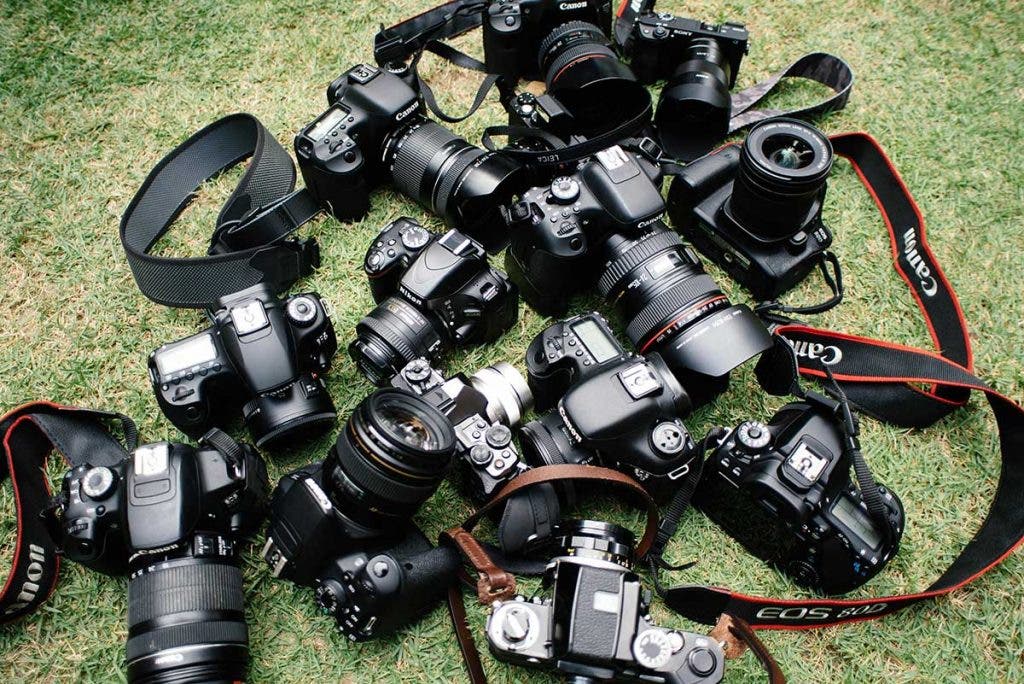
How Much Do Different Types of Cameras Cost?
Each type of camera ranges widely in price based on a variety of factors. Here’s what you can expect to spend on each camera type:
- Compact Digital/Point and Shoot Cameras: Prices can range from under $100 for a bare-bones, low resolution model, to more than $1,000 for more robust options.
- Bridge Cameras: Similar to point and shoot cameras, bridge cameras can cost anywhere from a few hundred dollars to about $1,000 for more feature-packed ones.
- Digital SLR Cameras: Introductory models can cost $400-$600 while professional quality cameras come in closer to $2,500 or more.
- Mirrorless Cameras: Small sensor mirrorless cameras often cost $1,000 or less, while full-frame mirrorless cameras can cost $2,500 or more.
- Medium Format Cameras: Digital medium format cameras can cost anywhere from $3,000 to upwards of $12,000 for high resolution options.
- Action Cameras: Most action cameras run from $250 to $500, but more expensive and less expensive options exist.
- 360 Cameras: You can find 360 cameras in the $100-$300 price range, but for higher-quality results, expect to spend at least $1,000.
- Film Cameras: 35mm options typically cost about $300 or less, while larger format film cameras can cost $2,000 or more.
- Instant Cameras: Instant cameras are the most affordable of the bunch and can cost anywhere from $50 to $150.
- Smartphone Cameras: Depending on whether you go for the Android or Apple system, a new latest smartphone camera will cost you about $1,000 to $1,600.
- Rugged Cameras: These weather-proof cameras come with many coatings and waterproof capabilities and will usually cost around $300 to $600.
How to Choose the Best Camera for You
Several factors must be considered carefully before investing into a camera system. What type of photography are you planning to do? What’s your budget? How realistic are you about carrying a lot of equipment with you when you travel? Do you have access to a robust computer and software suite to edit your images? How much video are you planning to capture alongside your photography? These are all important question to consider before plunging into a system.
If you’re planning to be a hybrid shooter (capturing video and photos), you might want to consider some of the mirrorless options that are optimized for both. If you’re going to be a pure landscape or studio portrait photographer and are looking for the highest image quality possible, then medium format may be your best bet. These are just two example scenarios. Make a list of what you really need vs what you can live without and making an informed decision. You may also consider renting equipment before making a purchasing decision.
Feature image via Shutterstock
